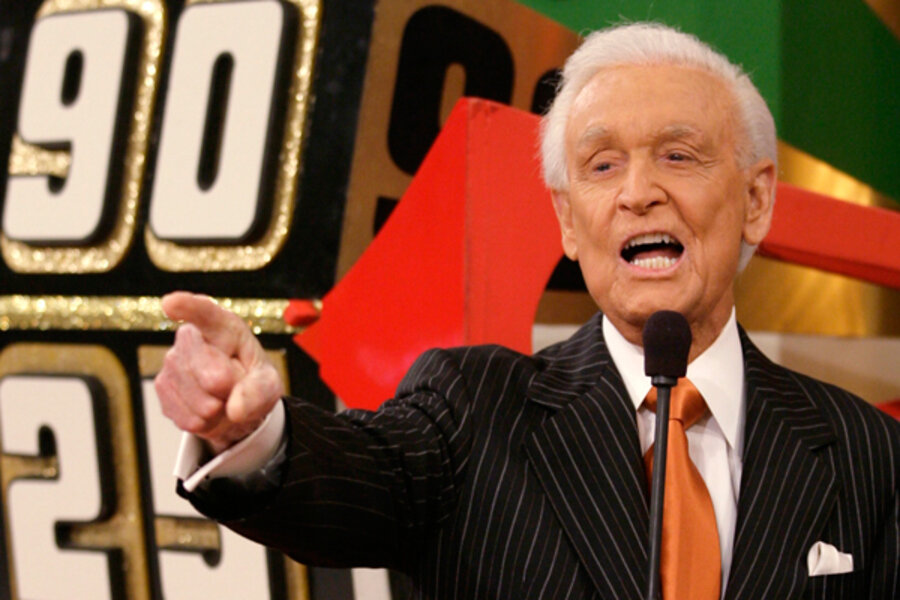How Bob Barker joined Sea Shepherd Paul Watson and the whale wars
Loading...
| Boston
Bob Barker made a fortune and became a popular figure in millions of American households thanks to his avuncular demeanor during his 35-year run on the US gameshow The Price is Right. But his warm smile and encouragement for contestants belied a more pugnacious side that has been revealed only in recent years.
In 1996, playing himself in the movie Happy Gilmore, Mr. Barker delivered a beating to Adam Sandler's titular character. Last September, he joined the pumped-up behemoths of World Wresting Entertainment to play "The Price is Raw," and forced wrestler Chris Jericho to back down after warning him, "I might have to take you over my knee."
But all that was a warm-up for the real confrontation that Barker's namesake, the Bob Barker, a 1,200-tonne former whaler, participated in earlier this week.
As Barker told the Associated Press, he met Paul Watson of the Sea Shepherd Conservation Society through mutual friends in the animal rights movement. Mr. Watson, who uses aggressive, confrontational tactics with a rag-tag fleet of black-painted boats against Japanese whalers every year in the Southern Ocean, made the following pitch, according to Barker: "He said he thought he could put the Japanese whaling fleet out of business if he had $5 million... I said, 'I think you do have the skills to do that, and I have $5 million, so let's get it on."
They got it on, and then some. First, the Barker was secretly converted, given Sea Shepherd's signature black paint job, and secretly dispatched to the Southern Ocean, flying a Norwegian flag. That ruse, making it appear that the ship was from one of the three last countries that support commercial whaling (the others are Iceland and Japan), was to fool the Japanese fleet into allowing the boat to get close. When they neared the Japanese fleet, the crew lowered Norway's flag and hoisted their preferred pennant: The Jolly Roger, the skull-and-crossbones flag associated with 17th- and 18th-century piracy.
Filming a collision from the Barker
On Tuesday, when Sea Shepherd's high-tech speedboat, the Ady Gil, collided with one of the Japanese ships – causing the front portion of the boat to sheer off – the Barker was on hand to film the incident and aid in the recovery of the Gil's crew and whatever equipment could be salvaged. The Gil was Sea Shepherd's most expensive acquisition before the Barker. In its previous incarnation as Earthrace, the carbon-fiber trimaran circled the globe in record time. It was donated to Sea Shepherd by the Hollywood camera-equipment mogul of the same name.
Barker told the Los Angeles TImes that he was proud his namesake was on hand. "By virtue of the Bob Barker being there, six lives were saved. The whole purpose is to sink the Japanese whaling fleet economically by making it impossible for them to harvest enough whales to continue to exist."
At least for now, the incident with the Gil has given the advantage to the whalers, who have steamed off in search of their prey while the Sea Shepherd fleet engages in recovery operations.
The Barker was acting as a replacement for Sea Shepherd's longstanding flagship RV Farley Mowat, named for the Canadian conservationist famous for authoring "Never Cry Wolf." The ship was seized by the Canadian government in 2008 after it collided with two coast guard ships as it sought to disrupt a Canadian seal hunt, and its captain was charged with approaching the seal hunt without a permit. The Canadian government took full ownership of the Mowat last year and is seeking to sell it to cover berthing costs and other charges. The Mowat was famous for painting on its side the tally of sunken whalers for which it took credit.
Watson said last December it was his intent all along to have the ship seized, since it was no longer seaworthy enough to keep up with Japanese whalers, and that, as a Canadian citizen, he'd intentionally avoided captaining the ship on that mission.
"I decided to send the ship on her final voyage straight into the arms of the Canadian Department of Fisheries and Oceans with the mission of documenting the 2008 Canadian slaughter of seal pups.... I spent a week goading and daring Fisheries Minister Loyola Hearn into seizing the ship with announcements stating that ‘he did not have the guts’ to take our ship in international waters. It was the classic Br’er Rabbit strategy of please don’t throw me in the briar patch when all the time Br’er Rabbit wanted to actually be thrown into the briar patch,” Watson wrote.
Animal rights a longtime Barker passion
Though most Americans know who Barker is and don't associate him with animal rights activism, it's a passion that he hasn't kept a secret. In the 1980s, he began signing off his show by reminding viewers to have their dogs and cats neutered. Bob Barker was a longtime host of the Miss Universe Pageant, and quit in 1988 when the producers would not ban the use of animal fur. Barker became a vegetarian in 1979 and in 1994 started the DJ & T Foundation, which subsidizes spay and neuter clinics for pets.





